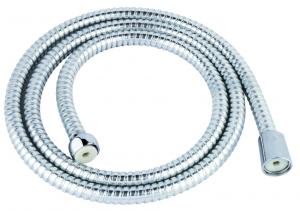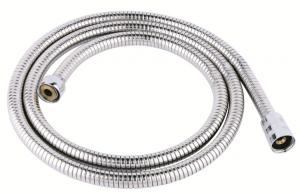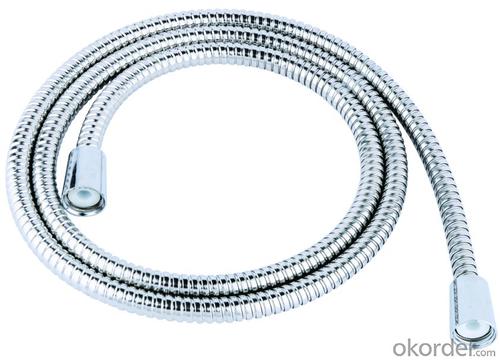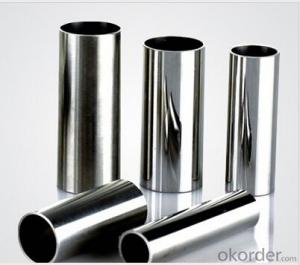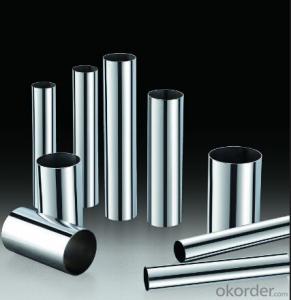stainless steel double lock or single lock shower hose with 58-3A brass nuts
- Loading Port:
- Ningbo
- Payment Terms:
- TT or LC
- Min Order Qty:
- 2500 PCS
- Supply Capability:
- 250000 PCS/month
OKorder Service Pledge
Quality Product, Order Online Tracking, Timely Delivery
OKorder Financial Service
Credit Rating, Credit Services, Credit Purchasing
You Might Also Like
Description of stainless steel double lock or single lock shower hose with 58-3A brass nuts
* 58-3A brass nuts and brass insert
* PVC inner tube or EPDM inner tube
* diamter: 13mm or 14mm
* length: 100cm-500cm
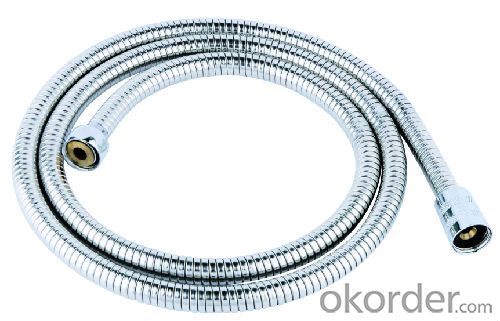

- Q: Can stainless steel pipes be used for underground sewage systems?
- Certainly! Underground sewage systems can indeed utilize stainless steel pipes. Due to its exceptional durability and resistance to corrosion, stainless steel is an ideal material for underground applications that frequently encounter moisture and chemicals. It can effectively endure the demanding conditions of sewage systems, including the erosive properties of wastewater and the pressure exerted by the soil. Moreover, stainless steel pipes boast an extensive lifespan, minimizing the necessity for frequent replacements and upkeep. Nevertheless, it is crucial to carefully assess the unique prerequisites and regulations of the local sewage system, and seek advice from experts to guarantee appropriate installation and compatibility with other system components.
- Q: What is the difference between OD and ID for stainless steel pipes?
- The difference between OD (outer diameter) and ID (inner diameter) for stainless steel pipes lies in their measurements. The OD refers to the overall size of the pipe, including its walls, while the ID measures the inner space or bore of the pipe.
- Q: Can stainless steel pipes be used for underground sprinkler systems?
- Underground sprinkler systems can indeed utilize stainless steel pipes. Stainless steel is renowned for its durability, corrosion resistance, and capacity to withstand extreme pressure and temperature. These characteristics render it an exceptional option for subterranean applications, where pipes are exposed to moisture, soil, and various environmental elements. Moreover, stainless steel pipes are non-reactive, guaranteeing that they won't pollute the water supply or compromise the quality of the irrigation water. Nevertheless, it is crucial to ensure the proper installation of stainless steel pipes, including suitable fittings and connections, to guarantee a dependable and effective sprinkler system.
- Q: Can stainless steel pipes be used for pharmaceutical cleanrooms?
- Yes, stainless steel pipes can be used for pharmaceutical cleanrooms. Stainless steel is a widely used material in cleanroom environments due to its excellent corrosion resistance, durability, and ease of cleaning. It is non-porous and does not harbor bacteria, making it suitable for pharmaceutical applications where cleanliness and hygiene are crucial. Stainless steel pipes also have high temperature and pressure resistance, making them suitable for various processes and applications within pharmaceutical cleanrooms. Additionally, stainless steel pipes can be easily welded and joined, ensuring a seamless and hygienic system.
- Q: What wire is used for welding of 316 stainless steel line?
- Apply A102 (E308-16) or A202 (E316-16) welding rodAttention should be summarized as follows: welding rod should be dry, low current, fast welding speed, interlayer temperature of about 60 degrees, intermittent welding, in order to avoid intergranular corrosion, immediately after welding water cooling.
- Q: Can stainless steel pipes be used for pharmaceutical industries?
- Yes, stainless steel pipes can be used for pharmaceutical industries. Stainless steel is a common material used in the pharmaceutical industry due to its excellent corrosion resistance, durability, and hygienic properties. It is resistant to chemicals, high temperatures, and moisture, making it suitable for various applications within pharmaceutical manufacturing processes. Stainless steel pipes are often used for transporting and storing pharmaceutical products, as well as for the distribution of purified water, steam, and other fluids. Additionally, stainless steel is easy to clean and maintain, which is crucial in ensuring the cleanliness and sterility required in pharmaceutical facilities.
- Q: 316 stainless steel pipe wall mirror polishing, the smaller the roughness, the better.
- Steel pipe is purchased separately, and then polished to find manufacturers alone, can meet the requirements,The cost is very high. To tell you the truth, I don't know.Specializing in sanitary stainless steel tube, stainless steel tube, precision sanitary stainless steel tube and stainless steel tube precision tube production and sales, the main material: stainless steel material: 0Cr18Ni9 (304 stainless steel tube) and 00Cr19Ni10 (304L stainless steel tube (316), stainless steel tube), 00Cr17Ni14Mo2 (GB 316L stainless steel tube), the products are widely used in instrumentation pharmaceutical machinery, food machinery, auto parts, pneumatic components, beverage, beer, drinking water, air purification and biological engineering and other fields.
- Q: What is the difference between the stainless steel pipe welded pipe and seamless pipe?
- Seamless tube is a strip of steel with a hollow cross section and no seams at all. The general is rolled into a cylindrical tube plate welding.
- Q: Can stainless steel pipes be used for heat exchangers?
- Yes, stainless steel pipes can be used for heat exchangers. Stainless steel is a popular choice for heat exchangers due to its high resistance to corrosion, durability, and excellent heat transfer properties. It can withstand high temperatures and pressure, making it suitable for various applications in industries such as chemical, food processing, and power generation.
- Q: What is the difference between seamless and drawn-over-mandrel stainless steel pipes?
- The manufacturing process and physical properties set seamless stainless steel pipes and drawn-over-mandrel (DOM) stainless steel pipes apart. When it comes to seamless stainless steel pipes, a solid cylindrical billet of stainless steel is pierced and then extruded to create a seamless tube. This process guarantees a uniform and consistent thickness throughout the pipe, resulting in a flawless and seamless look. Seamless pipes are renowned for their exceptional strength and resistance to pressure, making them suitable for applications that demand reliable and resilient piping systems. On the other hand, drawn-over-mandrel stainless steel pipes are formed by transforming a solid cylindrical billet into a hollow tube through a series of drawing operations. A mandrel is then used to refine the tube's shape and size accuracy. This method ensures that the pipe has a uniform wall thickness and a smooth inner surface. DOM pipes are known for their precise dimensions and tight tolerances, which make them ideal for applications that require exact fitting and unobstructed flow, such as those found in the automotive and hydraulic industries. In terms of physical properties, seamless stainless steel pipes generally boast higher tensile strength and yield strength compared to DOM pipes. This characteristic makes seamless pipes more suitable for high-pressure and high-stress applications, like those found in the oil and gas industry. DOM pipes, on the other hand, excel in dimensional control and surface finish, making them perfect for applications that require precise dimensions and smooth flow, such as those found in the automotive and hydraulic industries. To summarize, the primary difference between seamless and drawn-over-mandrel stainless steel pipes lies in their manufacturing process and physical properties. Seamless pipes are created by extruding a solid billet, resulting in a smooth and seamless appearance. DOM pipes, on the other hand, are formed by drawing a hollow tube from a solid billet, resulting in exceptional dimensional accuracy. The choice between these two pipe types depends on the specific requirements of the application, including pressure resistance, dimensional accuracy, and surface finish.
Send your message to us
stainless steel double lock or single lock shower hose with 58-3A brass nuts
- Loading Port:
- Ningbo
- Payment Terms:
- TT or LC
- Min Order Qty:
- 2500 PCS
- Supply Capability:
- 250000 PCS/month
OKorder Service Pledge
Quality Product, Order Online Tracking, Timely Delivery
OKorder Financial Service
Credit Rating, Credit Services, Credit Purchasing
Similar products
Hot products
Hot Searches
Related keywords

